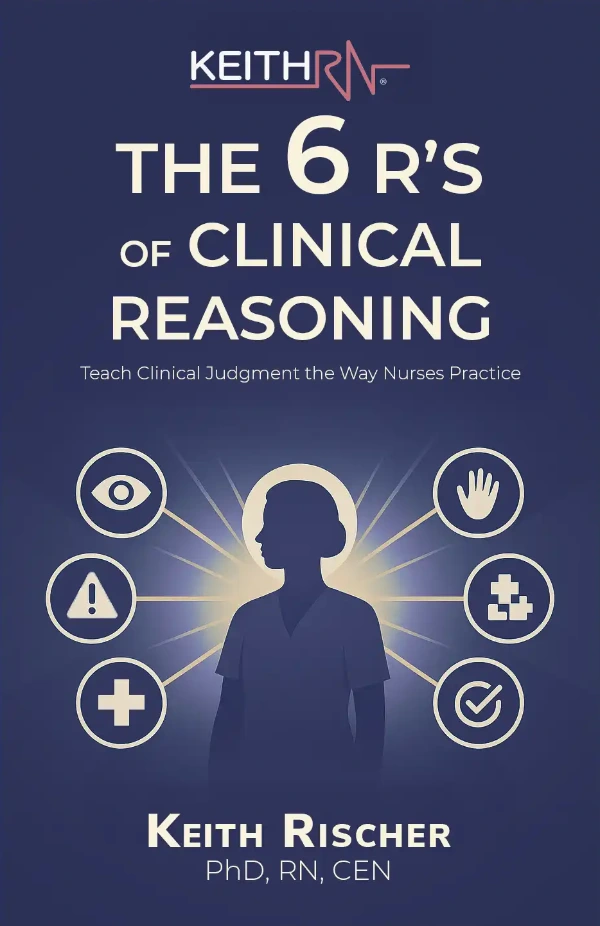
I recently cared for a 52-year-old woman who was brought to the ED by her family because she has been having nausea, and 2-3 episodes of vomiting and diarrhea over the last 12 hours.
I completed my nursing assessment and decided to perform an orthostatic blood pressure and HR to determine if there were any changes consistent with volume depletion.
I collected the following data:
Lying
- HR: 72/regular
- BP: 138/84
Standing
- HR: 92/regular
- BP: 130/80
Was this data collected negative or positive for orthostatic hypotension? Does the nurse need to continue to assess or does this finding require immediate intervention?
What would be your interpretation and subsequent nursing interventions?
In last week’s blog I discussed the essence of the definition of CO=SVxHR and why it must be deeply understood to strengthen the critical thinking as well as clinical reasoning by students and nurses.
Critical Thinking + Clinical Reasoning=CORRECT CLINICAL JUDGMENT
This is a foundational formula to clinical practice that places equal emphasis on why a nurse must be able to think critically as well as clinically reason (Alfaro-Lefavre, 2013).
Critical Thinking
Critical thinking in this scenario is demonstrated by the ability of the nurse to APPLY and USE knowledge regarding orthostatic hypotension by being able to correctly answer the following three questions:
- Does the blood pressure have to decrease from lying to standing in order to be positive?
- Can the heart rate increase from lying to standing with no change in BP, and can that also be a positive orthostatic finding?
- Do there have to be changes in both the heart rate and BP in order to be positive?
Clinical Reasoning
In order to clinically reason, the nurse must recognize the relevance or clinical significance of the data that is collected (Benner, Leonard, Sutphen, & Day, 2010).
If a student has a DEEP understanding of CO=SVxHR and can APPLY this essential concept to practice, the answers to these questions will become readily apparent and a correct clinical judgment will be made.
Clinical reasoning can be defined as the is the In order for every nurse to clinically reason, all clinical data collected must first be recognized as relevant or significant and then correctly interpreted to determine if a potential or actual problem is present (Benner, Leonard, Sutphen, & Day, 2010).
What is Your Interpretation?
How much of an increase or decrease in heart rate or BP is enough to be positive orthostatic changes?
If the nurse has a DEEP understanding of CO=SVxHR, he/she will remember that the FIRST compensatory response by the body is to INCREASE the heart rate to maintain adequate cardiac output whenever there is a fluid volume deficit because of dehydration, bleeding, septic shock, or vasodilation due to medications. Then the significance of this set of orthostatic vital signs becomes evident.
Before we can correctly interpret this set of orthostatic vital signs, BOTH the heart rate and BP are relevant and must be addressed separately as well as together.
Let’s answer these three questions:
Does the blood pressure have to decrease from lying to standing in order to be positive?
No. Because the FIRST compensatory response by the body is to INCREASE HR in any mild to moderate fluid volume deficit, BP can and will be maintained if the fluid volume deficit or shock state is EARLY and not progressed and profound.
Can the heart rate increase from lying to standing with no change in BP, and can that also be a positive orthostatic finding?
Yes. This is the same question as #1, just worded differently. A heart rate elevation with no change in BP must be interpreted as a POSITIVE orthostatic BP.
Do there have to be changes in both the heart rate and BP in order to be positive?
No as this was already addressed. But when both HR INCREASES and BP DECREASES this is a clinical RED FLAG! Though this may be a classic positive finding, it is not always seen clinically. If is observed, from my clinical experience it represents severe and profound fluid/blood volume loss because even though the HR is elevated, the patient is unable to maintain BP and is hypotensive.
A 21-year-old woman presented to the ED later that night with a suspected ectopic pregnancy, and bleeding internally. She had the following orthostatic findings:
Lying
- HR: 112/regular
- BP: 108/72
Standing
- HR: 138/regular
- BP: 80/48
This is an example of a real-life clinical emergency and must be interpreted correctly so life saving interventions can quickly commence!
Textbook Ambiguity
Fundamental textbooks contribute to the difficulties that some nursing students have to clearly define or recognize a positive orthostatic finding.
One textbook defines orthostatic hypotension as an increase in HR of more than 15% and a drop in systolic BP of more than 15 or diastolic drop of 10 mmHg or more (Potter & Perry, 2009).
While another textbook defines a positive orthostatic hypotension as a drop in systolic BP of 20 or diastolic drop of 10 mmHg with NO mention of the significance of heart rate when obtaining (Berman, Snyder, & Frandsen, 2016).
Remember 20!
How much does the heart rate have to increase to constitute a POSITIVE orthostatic finding? How much does the BP have to drop to be POSITIVE? By simplifying the essence of textbook definitions and my lens of clinical practice all a nurse needs to remember is the number 20.
- If the HR INCREASES 20 from lying to standing, this is a POSITIVE ortho finding.
- If the systolic BP DECREASES 20 from lying to standing, this is a POSITIVE ortho finding.
- If both HR and systolic BP are impacted by 20, recognize the significance and this is a doubly positive finding!
Defining Acceptable Ambiguity
If patients only presented like textbooks, applying knowledge to practice would be so much easier for novice students! Unfortunately, textbook presentations are typically found most commonly in textbooks, not in real-world clinical practice!
But do not be rigid or concrete with the number 20.
A change in 10-20 can also be clinically significant depending on the patient and their weight and other distinctives.
What if your patient is on a beta-blocker such as atenolol? How will that impact orthostatic findings? You will not likely see any HR changes, but may see a BP drop only. This is an excellent example why the mechanism of action of commonly used medications such as beta-blockers must be deeply understood by the nurse and is needed in order to critically think.
Be the Needed Change !
Nursing education is still in need of radical transformation (Benner, Leonard, Sutphen, & Day, 2010)! To be a part of the needed change, emphasize what content is MOST important to clinical practice.
Resist the temptation to cover textbook knowledge abstractly. Situate to the bedside this content on orthostatic hypotension so students deeply understand it!
This is one of the reasons I wrote the student text THINK Like a Nurse, to not only help students understand clinical reasoning, but identify essential content that must be deeply understood to APPLY and USE in the clinical setting including CO=SVxHR!
FREE Download!
My students struggled with understanding this patho formula and its relevance to clinical practice. I have a FREE clinical reasoning case study that includes contextualizing orthostatic changes to early sepsis.
Just click the button below to download and receive in addition my templates to build your own!
In Closing
In order to transform nursing education, educators must guide students to identify what content is most salient and relevant to clinical practice (Benner, Leonard, Sutphen, & Day, 2010).
CO=SVXHR is one of these essential concepts of perfusion that must not only be taught but deeply understood by every nursing student before they leave your program.
Make it a priority to contextualize this essential concept to practice through clinical scenarios that you may see in your clinical setting or through scenarios that I have created in my clinical reasoning case studies.
By guiding students to deeply understand CO=SVxHR, you will be a part of the needed transformation in nursing education that will strengthen student learning and also prepare them well for real-world clinical practice!
What do you think?
How do you integrate and emphasize CO=SVxHR in your clinical or classroom education?
Comment below and let the conversation begin!
References
- Alfaro-LeFevre, R. (2013). Critical thinking, clinical reasoning, and clinical judgment: A practical approach. (5th ed.). St. Louis, MO: Elsevier–Saunders.
- Benner, P., Sutphen, M., Leonard, V., & Day, L. (2010). Educating nurses: A call for radical transformation. San Francisco, CA: Jossey-Bass.
- Berman, A., Snyder, S. & Frandsen, G. (2016). Fundamentals of nursing. (9th ed.). Upper Saddle River, NJ: Prentice Hall.
- Potter, P. A. & Perry, A. G. (2009). Fundamentals of nursing. (7th ed.). St. Louis, MO: Mosby–Elsevier.
Go Deeper…
I wrote THINK Like a Nurse: Practical Preparation for Professional Practice to put an exclamation point and highlight the essence of what is NEED to know content from nursing education including CO=SVxHR!
Both students and nurse educators have found this resource helpful to deeply understand what is most important so it can be readily applied to the bedside!
See for yourself how this text can partner with you as an educator to prepare your students for real-world clinical practice!
Keith Rischer – PhD, RN, CEN
As a nurse with over 35 years of experience who remained in practice as an educator, I’ve witnessed the gap between how nursing is taught and how it is practiced, and I decided to do something about it! Read more…
The Ultimate Solution to Develop Clinical Judgment Skills
KeithRN’s Think Like a Nurse Membership
Access exclusive active learning resources for faculty and students, including KeithRN Case Studies, making it your go-to resource.




